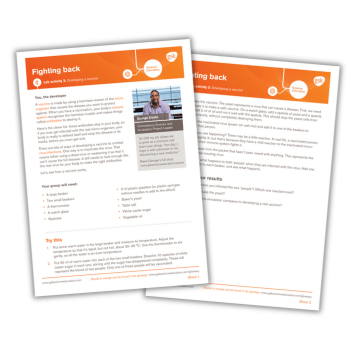In this vaccination KS3 activity, students will learn that a vaccine is made by using a harmless version of the microorganism that causes the disease you want to protect against.
When you have a vaccination, your body’s immune system recognises the harmless invader and makes antibodies to destroy it.
The aim of this lesson is to provide a visual and hands-on understanding of how vaccines work at a basic level, emphasising the concept of inactivation for safety and the body’s response to vaccination and subsequent exposure to a pathogen.
Vaccination KS3 experiment
Students will do an experiment to develop their own vaccine. Simulate the effect of vaccination using a simple model where yeast represents a virus, sugar water represents the blood of two individuals, and a mixture of yeast, oil, and salt acts as a vaccine.
Observe the difference in reaction, representing how a vaccinated individual might respond differently to exposure to a disease compared to an unvaccinated individual.
You will need:
- Large beaker and two small beakers
- Thermometer
- Watch glass
- Spatulas
- 3 ml plastic pipettes (or plastic syringes without needles to add to the effect)
- Baker’s yeast
- Table salt
- White caster sugar
- Vegetable oil
GSK is a science-led global healthcare company. GSK Stem Education wants to share a passion for science with students and their teachers everywhere. This resource forms one part of a topic on ‘Fighting Back’. Find more resources below:
Host a debate on vaccines.











